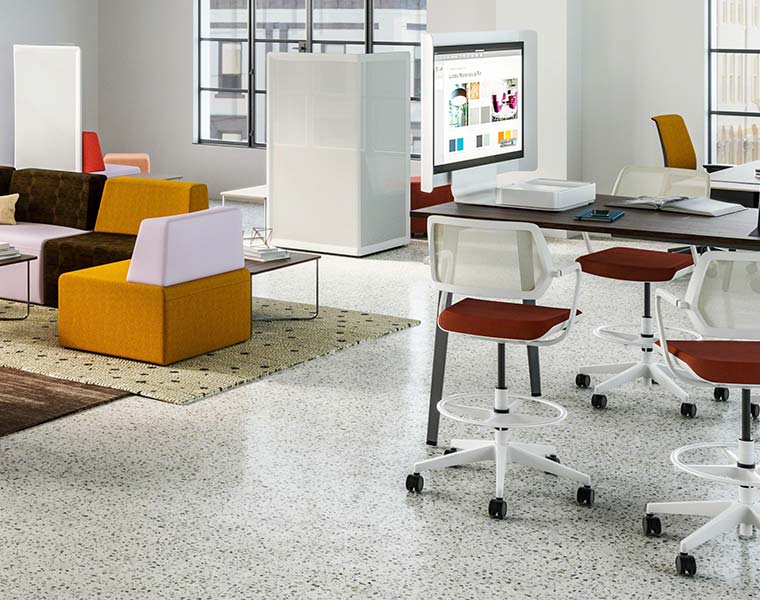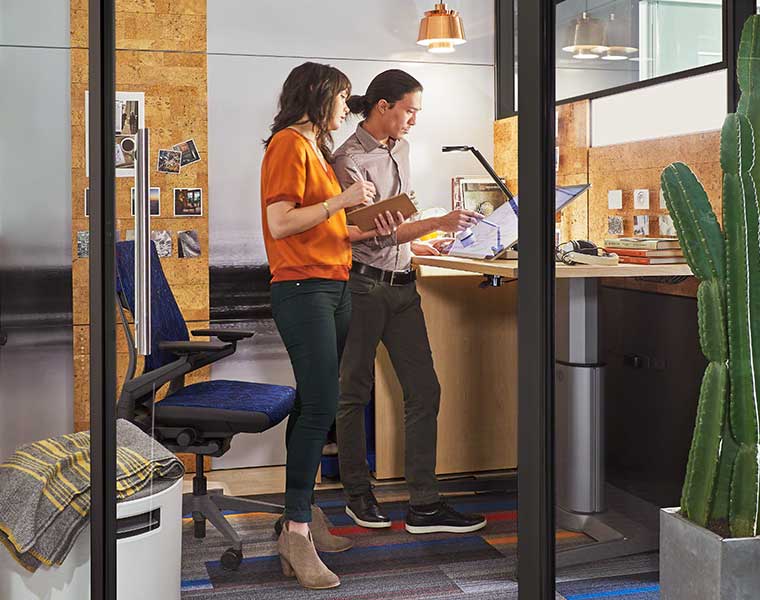A traditional definition of teamwork would typically suggest breaking away from a setting where you have been working by yourself into an area where you work with multiple people. The group work would be carried out to achieve the end objective and then members would probably return to their individual work.
More recently, however, the profile of teamwork has become far less structured. Teams today are becoming more fluid, more flexible and noticeably nonlinear in their approach to collaboration and group problem-solving. In fact, we are now seeing more regular use of the term ‘hyper-collaboration’.
Steelcase uses the comparison between a swimming team and a football team to demonstrate how behaviours around group work have shifted…
While a swimming team works using a linear structure of speed and individual responsibility, a football team is more interconnected, dynamic and collaborative in its approach. While a swimmer will stay in their lane, a football player will weave, transition, move around freely and rely on each other for support.
In fact, there was a great deal of food for thought in the most recent edition of the Steelcase 360 Magazine which got our experts thinking. A comment which our Space Strategists and Interior Designers particularly resonated with was from Vanja Misic from the Steelcase Workspace Futures team who said:
“A lot of environments today throw everyone into the same general space and say, ‘collaborate’. And, we’re surprised when it doesn’t work and people feel frustrated. Teams do not have the control they need to move easily from activity to activity.”
In the same way individual employees now need more freedom and professional autonomy, teams need the same choice and control in order to operate effectively in the modern workplace. This has been summarised nicely by Workplace Innovation+ Vice President, Gale Moutrey who said:
“Teams today need to navigate a fast-paced flow, bouncing between team members, iterating and improving on each other’s ideas. Everyone is accountable to keep work moving forward.”
This links back to the idea of group work and team problem-solving now being nonlinear and dynamically interconnected.
It goes without saying that collaboration has been a prominent concept for a long time now and something the commercial design industry as a whole has been doing more and more to facilitate. However, it’s now time to recognise this next period of significant evolution.
Office design strategy for the teamwork of today
According to some earlier research carried out by Steelcase, companies that promote collaboration in the workplace are 5x more likely to be high performing and more profitable. Steelcase also discovered that nearly everybody (97%) feels that collaboration is important to their work and 90% believe that it is an effective way to generate better ideas.
So, we know we need to make collaborative work user-centric, easily accessible and functional but how can we do that to accommodate the new styles of teamwork today? Our experts have put their heads (and wealth of experience) together to give you some pearls of wisdom ahead of the curve…
Private focus work
One of the most important things to realise with this regeneration of teamwork is that it no longer has to mean you can only contribute by physically being within a group setting. The new fluidity around teamwork styles means that people can come and go from the ‘team’ and still be accountable in moving forward.
For example:
A group might come together to discuss a task, problem or brief. A member of this team may then need to physically move away from the group in order to find a place where they can concentrate, digest information, research, read or make a phone call in peace and quiet.
“Team members sit together so they can stay connected and work faster. They also need moments of retreat from the group to focus, absorb information and process their own ideas.” – Steelcase 360
The solution?
A strategic combination of collaborative working environments where groups can interact and share ideas, and enclosed or semi-shielded settings where individuals can go to focus when they need isolation, privacy, low noise levels and minimal visual distraction.
Alternatively, you might have a member of the team who fuels their creative process by spending time in more relaxed environments like social spaces where idea-sharing can flow freely and communication is more casual.
Click for our advice on how to create privacy in an open plan workspace.
A workplace which is inclusive of all personalities
The above relates closely to the wider importance of creating an ecosystem of neighbourhoods and microenvironments in order to provide a variety of work settings for a diverse spectrum of employee (or team member).
This is all part and parcel of creating a more inclusive workplace and ensures that all members of a team can contribute equally, comfortably and effectively to the group effort. People now need to be able to ‘float’ physically and mentally when part of a project in order to perform to their full potential.
Teamwork in the traditional sense of the word can be an intimidating prospect for those with a more introverted personality, for example, so it’s vital that your workspace enables different types of people to contribute in their own preferred ways.
Facilitating both digital and analogue work
Another part of creating this inclusive and diverse working environment which makes way for these fluid and flexible teams is providing resource for both digital and analogue work.
Technology equipped settings and tech-integrated furniture will satisfy those who work best digitally, while things like write-on walls, pinboards and tech-free brainstorm areas will support those who like to work in analogue.
Click for further reading on how to facilitate both digital and analogue creativity in the modern workplace.



